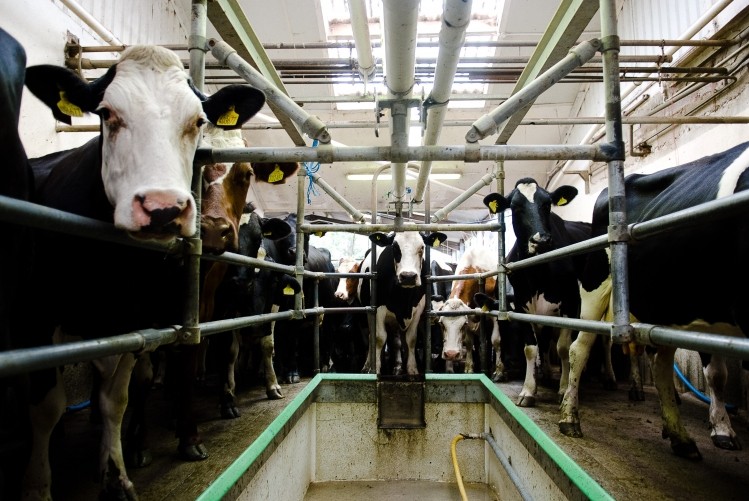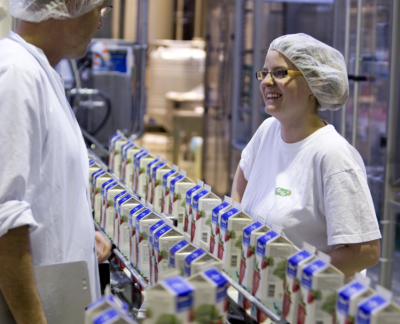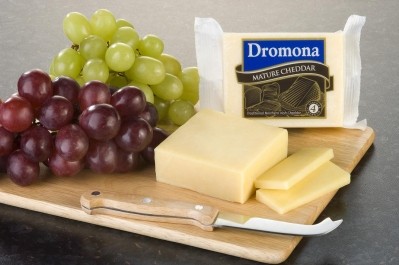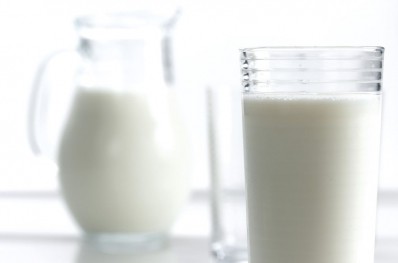Efficiency is the key for dairy survival

Two dairy cows were herded through the Asda supermarket in Stafford during a protest over how little dairy farmers are paid for milk on August 9 this year.
Police were called after the two heifers and around 70 protesters entered the store and congregated by the milk section. The protest highlighted pressure group Farmers For Action’s anger over the fact that farmers lose approximately 6p on every litre of milk they produce.
The average farm-gate price for milk was 23.66p per litre, the lowest for five years and down 25% in the past 12 months, the Department for Environment, Food and Rural Affairs said in June. However, farmers estimate that it costs between 30 and 32p to produce a litre of milk.
Herding the cows into a supermarket put the media spotlight on the profitability problem, but the dairy industry is also focused on improving processing efficiency in all areas and developing added-value products as it fights back.
Canice O’Reilly, marketing manager for LAC Conveyors says that “a steady number” of dairy companies are investing in big budget projects. Efficiencies in manufacturing are now imperative to keep profits up, she says, which in turn can also keep some dairy farmers in business.
“With milk production exceeding demand in the UK, dairy producers are looking for different ways to enter new markets to add value to their products,” says O’Reilly.
Added value production (Return to top)
There are over 30 different dairy products which can be produced, from ice cream to yogurt. So there are ample opportunities for adding value to raw milk.
There are also significant opportunities in health foods and drinks, such as lactose-free milk, whey protein and instant formula for babies. Demand for ethnic foods, such as Paneer Indian cheese, are ialso increasing in the UK. And by using efficient production and packaging systems, smaller-scale speciality producers are able to raise their profitability.
For example, one of LAC’s clients in Wrexham has cut its costs by installing a blow moulding bottle making machine next to its dairy, O’Reilly says. Instead of shipping in empty bottles from afar, the farm can now produce dairy products and bottle them immediately, thanks to a conveyor system joining the two machines.
“It’s certainly a desperate time for UK dairy farmers and it seems that only the ones with the greatest efficiencies and most effective produce will survive,” says O’Reilly.
Dairy processing plants must indeed focus on efficiency, adds Earl Yardley, director of Industrial Vision Systems, which has recently seen a big increase in dairy producers requesting automated vision inspection systems for their production lines. Inspection systems can pinpoint crushed boxes, missing boxes, damaged trays, splices, extra boxes, and wrongly positioned box flaps and tabs with immediate and continuing improvements in quality and efficiency. This ensures that they receive high quality products and as a result, save money.
Yardley says the latest dairy product inspection machines include high definition camera technology combined with an easy-to-use graphical touchscreen set-up to allow label types, styles, packaging and printing to be checked in real time. The machines include conveyor and rejection systems to allow them to operate as integrated production lines.
“Automatically inspecting every label, date code, seal and packaging leaving the factory is now a pre-requisite to protect [producers] and their products against potential customer complaints and loss of contracts from the large supermarkets,” says Yardley.
Meanwhile, supplier TrakRap reports increasing interest from the dairy sector in its shrink-wrapping machines.
Energy and material efficiency (Return to top)
“Energy and material efficiency plays an ever-increasing role in secondary packaging designs,” says chief executive Martin Leeming. “Some industry analysts are now predicting that the next 10 years will see sustainability overtake cost as the number one purchasing decision.
“Efficient solutions that consume fewer resources, use fewer materials throughout the supply chain and are quantified by life-cycle analysis will become the norm.”
TrakRap recently worked with UK dairy farmer co-operative Dale Farm, part of the United Dairy Farmers Group, to replace three shrink wrapping machines used to package yogurts and crème fraîche for distribution from its Kendal site. It offered a no capital expenditure finance scheme in which Dale Farm is paying on a cost per case basis, allowing it to make savings without significant expenditure.
The existing ageing kit at Dale Farm’s site had become unfit for purpose and sometimes resulted in unplanned downtime due to equipment failure.
The system installed eliminated the use of heat, using a recyclable polymer film and reduced Dale Farm’s film usage by 68%, achieving a 71% carbon dioxide reduction, equivalent to 87t/year, and a lower cost per pack. It has also reduced Dale Farm’s pack wrapping energy use by 95% a year.
Typically, food industry heat tunnels such as the ones used by Dale Farm are rated around 30kW/h and over a two-shift system, three tunnels can burn up to 125MW of electricity a year. Following the positive results from the first three machines, Dale Farm has now installed a fourth to produce a new line of cottage cheese for Sainsbury. This is its first venture into own-label cottage cheese, requiring significant investment to increase capacity.
Ice pigging (Return to top)
Meanwhile, analysis conducted by the Carbon Trust suggests that the dairy industry could make significant savings and improve profitability by introducing ice pigging, or flushing, into commercial dairies, as well as reducing their environmental impact through the disposal of much reduced levels of effluent and chemical waste.
Having a fully integrated ice pigging system within a dairy facility can deliver a potential £115,000 of extra savings a year through reduced downtime for cleaning and maintenance, through increased productivity, and a greater volume of product left available for sale. These increases in revenue will more than offset the initial capital investment needed to integrate ice pigging into the production facility.
Ice pigging allows lines to be cleaned by injecting ice slurry through them, reducing energy and water use. In recent trials, ice pigging supplier Aqualogy Environment tested the technology on the Yeo Valley ‘Surprise’ production line. The results showed a potential increase of £350,000 a year in revenue for the company through product recovery.
“Ice Pigging technology has great potential for the dairy and food industry,” claims Andrew Rimell, general manager of Yeo Valley’s Newton Abbot site. At the end of this month (November) Aqualogy will launch a ‘factory ready’ AQL500 hygienic ice pigging machine, which can be used for line cleaning and improved product recovery on process lines even for lines previously deemed as un-piggable.
CheesE mite controls (Return to top)
And, at the artisan end of the market, cheesemaker and dairy farm Quicke’s has developed an innovative way of dealing with the bane of the artisan cheese sector, the cheese mite. The cheese mite is related to the house dust mite and is normal on traditional cheese.
Quicke’s, based in Devon, lays claim to being the largest British naturally matured traditional cheddar maker. It is run by 14th-generation family owner Mary Quicke, an authority on traditional cheese production who was awarded an MBE for her contribution to farming and cheesemaking in 2005.
Quicke says that her company was seeing 21% wastage on the cheese in 2009 due to the cheese mites which live on the fat of the cheese and can break the seal around the cheese and get in if undisturbed. Until 2006, traditional cheddar cheesemakers had controlled cheese mite with the fumigant methyl bromide. However, this was found to be harmful to the wider environment and was subsequently banned by the European Commission that year.
Quicke’s tried many other control methods to address the problem: ultraviolet treatment, dry ice, heat tunnel, low oxygen and ozone, but none was effective. Other fumigants have been found to be ineffective or lead to tainting of the cheese. The only control measures used were brushing and vacuuming, which were slow and not very effective. As a result, mite numbers rose to catastrophic levels.
Quicke’s designed and commissioned its own ‘suck and blow’ chamber with self-turning racks, high pressure air and a dust extractor and filter in 2010, Quicke says. With the system, mites drop into a dump bucket and no chemicals are used. The method is three or four times as fast as the alternative, vacuuming the cheeses. No mycotoxins have ever been found on the cheese affected by internal mould, so it should be seen as a blemish rather than a health or hygiene risk, she adds.
Since being adopted, the £2M turnover cheese company’s wastage has reduced to less than 2%. Quicke’s also claims it has enabled it to age its cheese further than other traditional cheese producers. Its Vintage Cheddar, at two years old, is one of the oldest naturally-aged traditional cloth-bound cheddar available on the market, it claims.
It is survival of the fittest in the dairy industry at the moment, and investment in efficiency is the way forward. The only problem is finding the funds to invest – hence ‘pay as you go’ style finance schemes could be the answer.

















